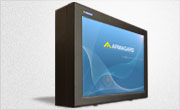The Differences between Indoor and Outdoor Digital Signage
Posted by: Richard Williams | Posted on: | 1 Comments
Outdoor digital signage has a long way to go before it catches up with indoor advertising displays and signage screens. But increasingly more and more installs are going in outdoor locations as advertiser realise the potential that the larger audiences in outside locations can generate.
But there are big differences in installing an LCD or plasma screen in an indoor location for digital advertising or information than there is for outdoor digital signage. If embarking on an outdoor campaign, there are four main differences that need to be analysed to ensure protection:
Weatherproof
Keeping the screen dry and out of the wind, dust, hail, snow and rain is vital for any outdoor digital signage screen. Even the smallest amount of moisture can disable a screen so finding a weatherproof LCD enclosure or other outdoor signage enclosure is the first step to providing adequate protection.
Rugged
Accidental impacts in outdoor locations are all to commonplace. From boisterous parents with buggies to careless road sweepers; the risk of disablement is constant in an outdoor location. And deliberate attacks from vandals and even thieves are also sadly commonplace so ensuring the outdoor digital signage system is rugged enough to withstand vandals and impacts is crucial.
A solid steel digital signage or LCD enclosure is therefore important for most outdoor screens as is a shatterproof screen or other anti-vandal measures.
Brightness/sun
The sun can cause a number of problems in outdoor locations. Firstly, sunglare can diminish the brightness of the screen so it is important to use a TV device that is as bright as possible to start with. Anti-glare measures such as anti-reflective glass can help as can siting the sign so it is not in direct sunlight.
However, if sunglare is a unavoidable, protecting the screen from damage caused by this continuous light and heat is also important as the sun can permanently scar a modern TV device like an LCD or plasma.
Temperature
Another consideration if outdoor locations are the ambient temperature, which in most outdoor locations can vary depending on the time of year.
Any outdoor digital signage screen that has to cope with sub zero temperatures will need to have adequate heating installed inside the LCD enclosure whilst if the summer temperatures exceed the optimum operating temperatures for the device then additional cooling, and in extreme circumstances, air conditioning need to be considered.
Post shortlink:
Popular Products
LCD Enclosure
Need armor for your LCD/LED screen(s)? Outdoors or inside the versatile LCD enclosure protects against thieves, vandals & the weather. Installation idea: NFL stadiums.
Outdoor Digital Signage
Exclusive 46” outdoor screen protection. Dubbed the ‘Totem’, due to its distinct design, it repels damage threats, but attracts audiences. Installation idea: Drive-thru restaurants.
Portrait Flat Panel Enclosure
Safeguard your eye-level advertising display screen(s), indoors or outdoors. Completely customizable, add exciting features like touch screen technology. Installation idea: Restaurant frontages.
Indoor Digital Signage
Popular purchase for retail outlets! Great for ‘point of sale’ persuasion, boost your brand with static & motion advertising from a single unit! Installation idea: Mall of America.






